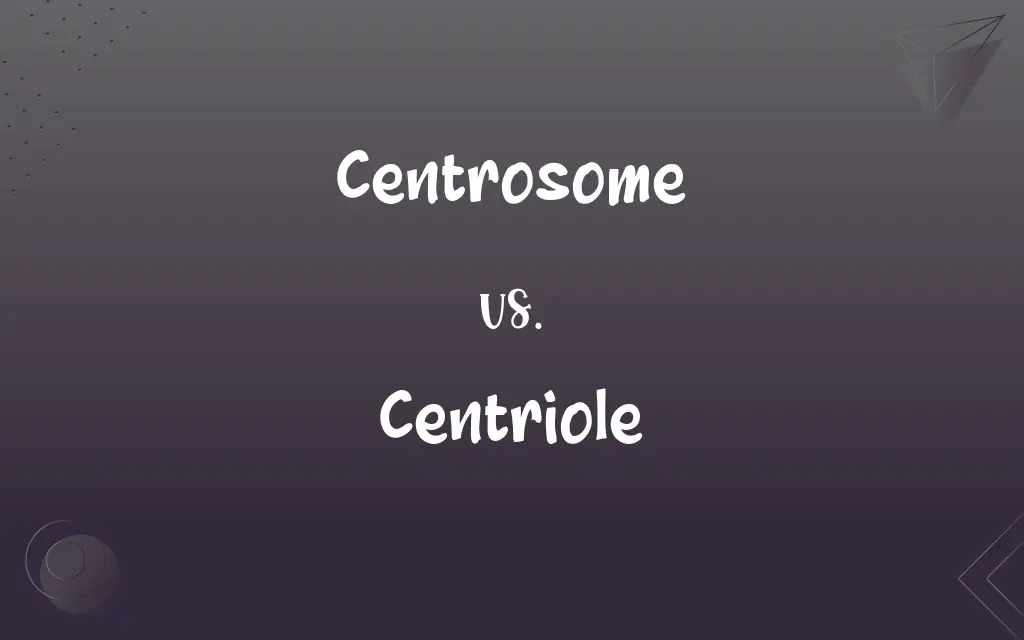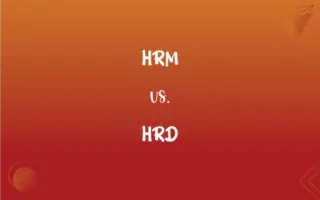Centrosome vs. Centriole: What's the Difference?
Edited by Janet White || By Harlon Moss || Updated on October 29, 2023
Centrosome is a cell organelle that organizes microtubules; centriole is a component of the centrosome.

Key Differences
The centrosome is a cellular structure involved in organizing microtubules, playing a key role in cell division. It consists of two orthogonally arranged centrioles surrounded by pericentriolar material.
Centrioles are cylindrical structures found within the centrosome, composed of microtubules arranged in a specific pattern. They help in forming cilia and flagella and are crucial for spindle formation during cell division.
Centrosomes serve as the main microtubule organizing center (MTOC) of the cell, providing a structural framework. In contrast, centrioles, as part of the centrosome, specifically aid in the formation of spindle fibers.
While the centrosome is a larger organelle orchestrating cell division and microtubule organization, the centriole, as a component of the centrosome, has more specialized functions related to spindle pole formation.
Centrioles duplicate independently of the centrosome, suggesting their unique self-replicating nature. The centrosome, however, encompasses these centrioles, emphasizing its broader regulatory role in the cell.
ADVERTISEMENT
Comparison Chart
Structure
Larger organelle, contains centrioles and pericentriolar material
Smaller, cylindrical structure composed of microtubules
Function
Organizes microtubules, aids in cell division
Helps in spindle formation, involved in cilia and flagella formation
Composition
Includes two centrioles and surrounding material
Composed of nine triplets of microtubules
Role in Cell Division
Acts as the main MTOC, organizes spindle fibers
Forms the poles of the mitotic spindle
Replication
Does not replicate independently
Duplicates once per cell cycle
ADVERTISEMENT
Centrosome and Centriole Definitions
Centrosome
A cellular structure organizing microtubules and aiding in cell division.
The centrosome played a crucial role in the mitotic spindle formation during cell division.
Centriole
A cylindrical cell structure involved in cell division and forming cilia.
Each centriole migrated to opposite poles during mitosis.
Centrosome
The main microtubule organizing center (MTOC) of eukaryotic cells.
As the cell prepared to divide, the centrosome organized the spindle fibers.
Centriole
A structure that helps organize the mitotic spindle in eukaryotic cells.
The centriole played a vital role in aligning the chromosomes during mitosis.
Centrosome
An organelle containing two centrioles surrounded by pericentriolar material.
The centrosome's structure facilitates its role as the microtubule organizing center.
Centriole
A cellular organelle involved in forming basal bodies.
The centriole transformed into a basal body to form a flagellum.
Centrosome
An organelle crucial for proper spindle formation in cell division.
The cell's inability to divide was linked to a malfunctioning centrosome.
Centriole
A component of the centrosome composed of microtubules.
The centriole's unique microtubule arrangement is essential for its function.
Centrosome
A cell organelle that coordinates the assembly and disassembly of microtubules.
The centrosome's dysfunction led to aberrant microtubule organization.
Centriole
A self-replicating structure crucial for spindle formation.
The centriole duplicated in preparation for the next cell division.
Centrosome
A small region of cytoplasm adjacent to the nucleus that contains the centrioles and serves to organize microtubules.
Centriole
One of two cylindrical cellular structures that are composed of nine triplet microtubules and form the asters during mitosis.
Centrosome
(cytology) An organelle, near the nucleus in the cytoplasm of most organisms, that controls the organization of its microtubules
Centriole
(biology) A barrel-shaped microtubule structure found in most animal cells, important in the process of mitosis (nuclear division).
Centrosome
A peculiar rounded body lying near the nucleus of a cell. It is regarded as the dynamic element by means of which the machinery of cell division is organized.
Centriole
One of two small cylindrical cell organelles composes of nine triplet microtubules, which form the asters during mitosis.
Centrosome
Small region of cytoplasm adjacent to the nucleus; contains the centrioles and serves to organize the microtubules
Centriole
One of two small cylindrical cell organelles composes of 9 triplet microtubules; form the asters during mitosis
FAQs
Do all cells have centrosomes and centrioles?
Most animal cells have centrosomes and centrioles, but many plant cells do not.
How many centrioles are in a centrosome?
There are typically two centrioles in a centrosome.
What is a centrosome?
A cell organelle that organizes microtubules and assists in cell division.
How are centrioles oriented within the centrosome?
They are typically oriented at right angles to each other.
What is a centriole?
A cylindrical structure within the centrosome, involved in spindle formation and cilia development.
Can centrioles function independently of the centrosome?
Yes, centrioles can function in cilia and flagella formation independently of the centrosome.
Are centrosomes unique to eukaryotic cells?
Yes, centrosomes are typically found in eukaryotic cells.
Do centrioles have their own DNA?
No, centrioles do not contain DNA.
Are centrosomes active throughout the cell cycle?
Their activity varies, with heightened roles during cell division.
How do centrioles replicate?
Centrioles replicate independently once per cell cycle.
What is the role of centrioles in cilia formation?
Centrioles form basal bodies, which give rise to cilia.
What happens if a cell lacks centrioles?
The cell may have defects in spindle formation and cell division.
What is the significance of the pericentriolar material?
It helps in microtubule nucleation and anchoring around the centrioles.
Can a cell have more than one centrosome?
Normally, a cell has one centrosome, but it duplicates before cell division.
Can centrosome abnormalities be inherited?
Some centrosome-related disorders can be inherited.
What happens to the centrosome during cell division?
The centrosome duplicates and helps organize the mitotic spindle.
Are centrosomes present in prokaryotic cells?
No, prokaryotic cells lack centrosomes.
Can centrioles exist outside the centrosome?
Yes, during cilia formation, centrioles function outside the centrosome.
How do centrosomes and centrioles relate to cancer?
Abnormal centrosome or centriole numbers can lead to uncontrolled cell division in cancer.
What disorders are associated with centrosome dysfunction?
Disorders like cancer and microcephaly can be linked to centrosome abnormalities.
About Author
Written by
Harlon MossHarlon is a seasoned quality moderator and accomplished content writer for Difference Wiki. An alumnus of the prestigious University of California, he earned his degree in Computer Science. Leveraging his academic background, Harlon brings a meticulous and informed perspective to his work, ensuring content accuracy and excellence.
Edited by
Janet WhiteJanet White has been an esteemed writer and blogger for Difference Wiki. Holding a Master's degree in Science and Medical Journalism from the prestigious Boston University, she has consistently demonstrated her expertise and passion for her field. When she's not immersed in her work, Janet relishes her time exercising, delving into a good book, and cherishing moments with friends and family.































































